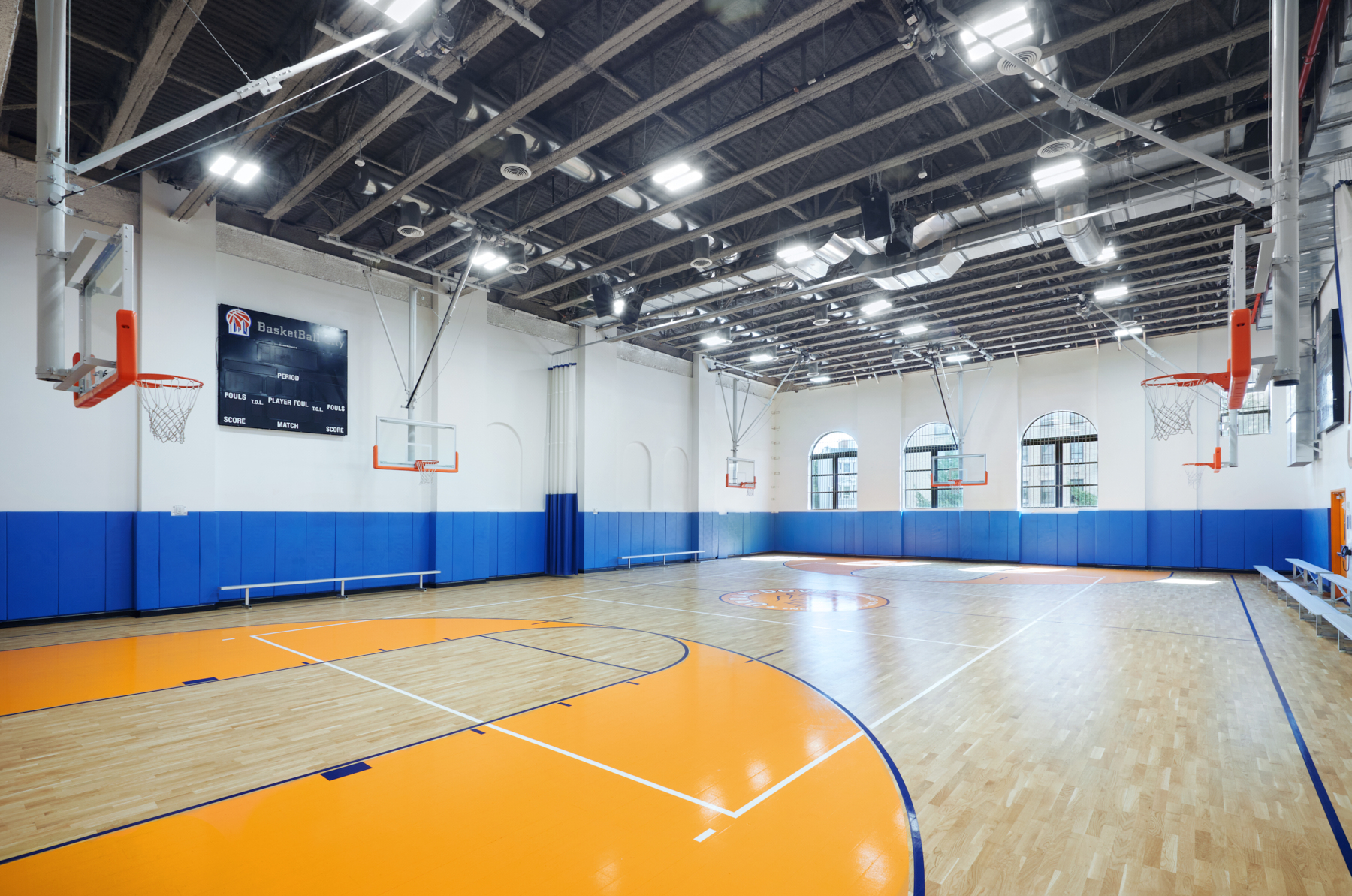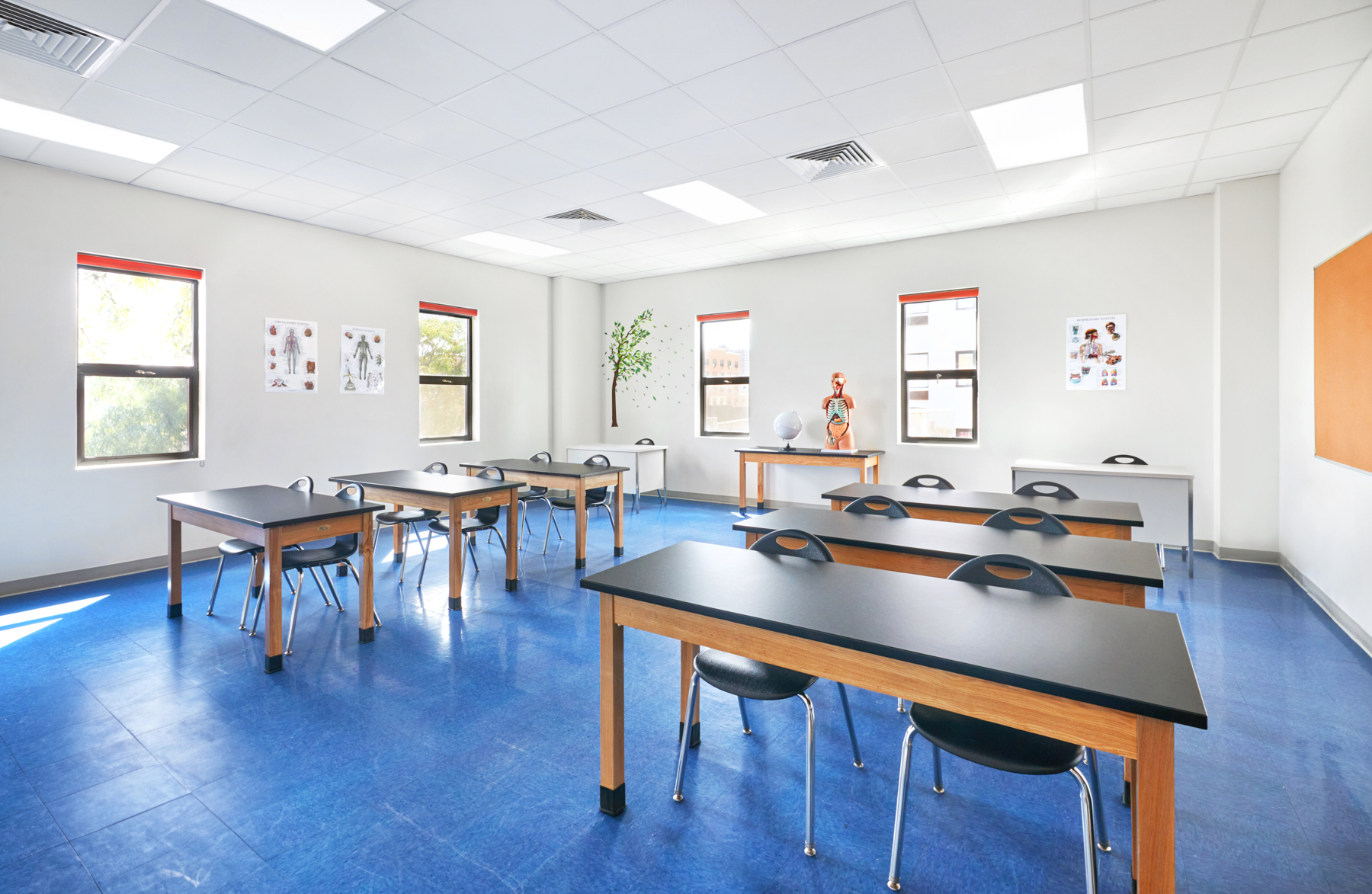Architecture Affiliate, MDA Completes Urban Dove Team II Charter High School in the Woodstock Section of the Bronx
Nivneh Capital Group/The Iconic Group Redeveloped and Expanded Three Commercial Buildings to House the High School
Bronx, NY – The Urban Dove Team II Charter School has opened its new transfer high school at 671 Prospect Avenue in the Woodstock section of the Bronx. Montroy DeMarco Architecture designed the school building’s renovation and expansion. Urban Dove is an innovative charter school focused on meeting the needs of students who are overage- and under-credited and off-track to graduate high school on schedule.
Urban Dove, established by Founder and Executive Director Jai Nanda, also operates a high school in Brooklyn, located at 1256 East 21st Street. The new school, named Urban Dove Team II Bronx, houses 300 students and 70 staff, who have relocated from a former location at 860 Forest Avenue in the Bronx.
The Bronx property owner Nivneh Capital Group/The Iconic Group and architect Montroy DeMarco Architecture (MDA) created the new campus for the charter school by combining, redeveloping, and expanding three adjacent commercial buildings within the Prospect Avenue site. Urban Dove rented the redeveloped property through a long-term lease and named it the Evan Leif Educational Campus in honor of one of the donors supporting the organization.
Nanda, a former teacher and basketball coach, recognized the positive impact team sports have on youth both inside and outside the classroom. He developed the Urban Dove program to utilize sports to teach at-risk teens the critical life skills needed to succeed. Two campuses are located in Brooklyn and in the Bronx.
“We have created a safe, supportive educational model that is successfully helping students get back on track to graduation,” said Nanda. “Our incredible students deserve an incredible facility, and we are so excited about this brand new, first class building where our students can continue to grow and learn. Montroy DeMarco Architecture designed a beautiful new school that will serve our Bronx students and faculty for years to come,” he added.
“The redevelopment included the gut rehabilitation of the adjoining three-story buildings and the addition of a fourth floor, to accommodate the needs of the growing school. We are very proud to include the Urban Dove Team Charter School among our tenants and to contribute to the improvement of the Woodstock neighborhood,” shared Hillel Fischman, Principal of The Iconic Group.
“This 39,000-square foot project combined three structures into one cohesive building that both meets the programmatic needs of Urban Dove and positively impacts the neighborhood by renovating previously underutilized buildings,” said Daniel Montroy, AIA, MDA Principal. “The three adjoining structures originally totaled 34,000 square feet, while the new fourth floor expansion added 5,000 square feet. A 1,900-square foot area on the street level is set aside for retail use,” he added.
Each Urban Dove student enrolls in a three-year personalized instructional program that leads to a high school diploma, develops job skills, and provides a foundation for higher education. Students spend 2.5 hours per day participating in sports, nutrition, and fitness activities that develop teamwork, healthy competition, and self-confidence. Coaches use sports to help students focus, manage emotions, and becomes positive members of a community.
The renovation and expansion project team also included structural engineer KPFF Consulting Engineers Inc., MEP engineer A&D Engineering LLP, and general contractor NY Major Construction & Development.
Design and redevelopment
The school site consists of three adjacent buildings on Prospect Avenue, facing east between 152nd and 155th Streets that have been combined into one lot. The site is within a short walking distance of the Prospect Avenue and Jackson Avenue subway stations on the Number 2 and 5 lines and the Longwood Avenue station on the Number 6 line.
Constructed around 1915, the buildings have masonry facades, which have been revised and architecturally unified during the renovation. The center building is steel framed, while the flanking building have timber structures. Prior to the redevelopment, the front façade of the southern building had been substantially concealed with both stucco and cultured stone, and original terra cotta ornamentation has been covered with paint. However, the front façades of the other two buildings were in relatively good condition, although the street levels had been modified in the past with the addition of retail storefronts and some brick has been painted.
Windows on the second and third floors are framed with monumental brick pilasters and triple rowlock arch surrounds with ornamental terra cotta and brick keystones, which have been retained during the renovation. The project team also preserved original decorative insets of dogtooth courses framed with rowlock brick borders that provide visual interest between the third-floor windows. A projected brick frieze runs below the roofline. The façade is capped with a terra cotta band and open brickwork cornice.
Prior to the conversion into the school, the buildings had been occupied by a variety of commercial and manufacturing uses, including most recently a billiards café and laundromat on the street level, and a church and dance hall on the upper floors.
It was essential for the new plan to include a high school regulation size basketball court, dance studio, and weight room to address the athletics component of the curriculum as well as comfortable classrooms for academics. MDA has completely redesigned the buildings to meet these requirements.
Utilizing the features of the existing façade, the school’s street level main entrance is now located at the center of the combined and unified structure, within an existing terra cotta surround. A new stairway and elevator provide vertical access to the other floors. Offices and five classrooms are located on the street level, and the layout has been configured to accommodate the retail component occupying the northeast corner. A large dance and yoga studio, a weight room, and a cafeteria occupy a majority of the cellar, which also houses a staff lounge, nurse’s office, and support spaces.
Creating the basketball court required major renovation and structural redevelopment work. The court was built on the second floor in the northern portion of the building. In order to obtain enough floor space for the court, the demising wall between the central and north buildings was removed and a new partition wall was built to divide the court from the remainder of both floors. The third floor above the court has also been removed to provide the required 25-foot vertical clearance. KPFF designed wide span steel trusses above the court to carry the load of the new fourth floor and roof above.
“Development of the new layout proved to be the project’s main design challenge,” says MDA Project Manager Mark Vella. “Through redesigning the space surrounding the basketball court and by adding a fourth floor, we have successfully met the athletic and academic needs of Urban Dove’s program.”
The remainders of the second and third floors house a total of five classrooms and several offices. Vision panels in the third-floor corridor provide a view into the court below. A new fourth floor addition features five additional classrooms, offices, and bullpens. The addition was constructed with light gauge framing and clad with EIFS (external insulation finishing system).
“The front façade has been modified to present a unified design. Portions of the existing parapet wall have been removed to permit integration of the new fourth floor façade, and the remainder of the exposed brick has been repaired and repointed,” explains Vella. The southern, visually compromised portion of the façade has been replaced with a new brick veneer to match the existing adjacent areas. New aluminum frame windows have been installed throughout the building, and three new monumental window units have been installed within the existing masonry arches to provide light into the basketball court. Roofing is an EPDM (ethylene propylene diene terpolymer) membrane.
The basketball court features a hardwood floor installed over sleepers and shock absorbers to provide player comfort and sports performance properties. Lights are high efficiency LED fixtures.
In addition to serving students and faculty, the building has also become an asset to the community, as Urban Dove has made the basketball court available for community use outside of school hours. In addition, the renovated front façade will create a focal point that will enliven this portion of Prospect Avenue.
Nivneh Capital Group and The Iconic Group
Nivneh Capital Group, in collaboration with The Iconic Group, partnered on a mission to acquire, develop or redevelop, and operate a highly select and diverse portfolio of commercial, residential, and industrial rental properties in and around New York City. By focusing on well-situated land and underperforming structures of all use-groups, the two firms concentrate on providing these assets the operational expertise, attention, funding, and improvements they require to appreciate in value. The two companies have grown a sizable portfolio of cash-producing real estate at the heart of the greatest city in the world. While focused on generating annual returns at its core, Nivneh and Iconic are also dedicated to improving the lives of their tenants and the communities they call home.
Montroy DeMarco Architecture
Based in New York City, Montroy DeMarco Architecture (MDA) is a prominent architecture and planning firm predominantly serving office, commercial, institutional, retail, multi-family, senior housing, and hospitality markets in the greater New York area. MDA’s affiliate Montroy Andersen DeMarco (MADGI) provides interior design services to commercial, institutional, and multi-family clients. Three principals lead the studios: Daniel Montroy, AIA; Richard J. DeMarco, AIA; and Steven Andersen. The affiliated studios employ 30 architects, interior designers, LEED professionals, project managers, and support staff. Building Design & Construction magazine recently ranked the firm as the 82nd largest workplace designer and the 155th largest designer overall in the United States. Engineering News-Record lists MDA as the 87th largest design firm in the New York/New Jersey region.
MDA’s markets include commercial, office, educational, retail, entertainment, institutional, and residential and mixed-use redevelopments and new buildings. The firm is recognized for its expertise in commercial property conversions and market repositionings. Headed by principals, the specialized studios have served as designer for some of the most innovative – and challenging – projects in New York City. MDA is known for its design quality and expertise in cost control, technology, and addressing complex zoning regulations.
The firm was the design force behind the headquarters offices of a multitude of global corporate bluebloods and technology firms such as TravelClick, National Futures Association, SOCOTEC, Mediabistro, and Mimeo, among others. MADGI’s recent corporate interior work also includes the 150,000-sq.-ft. East Hanover, N.J., U.S. headquarters and laboratories and the 75,000-sq.-ft. Manhattan offices and testing labs of Givaudan Fragrance. The studio has designed more than 10 million square feet of office and common use space for both tenants and leading commercial landlords in New York City, including Colliers International, Capital Properties, The Durst Organization, John Hancock, and Barings.
MDA’s architectural, executive design, and design collaborations portfolio includes the 230-room citizenM New York hotel in Times Square; the 183,000-sq.-ft., 17-story 20 East End Avenue luxury condominium; The Dillon Townhouses and Condominiums, a 205,000-sq.-ft residential complex at 425 West 53rd Street that received an AIA New York State Award of Merit; the 11-story 560 West 24th Street luxury condominium; the 82,000-sq.-ft. Soori Highline luxury condominium on West 29th Street; and the market repositioning of the 100,000-sq.-ft. 160 Fifth Avenue office tower in Manhattan as well as the $330 million redevelopment of The Watermark at Brooklyn Heights luxury senior living community in Brooklyn, NY and the 10-story, 85-apartment Silver Star residential/retail mixed-use building in Long Island City, NY.
MDA recently served as the architect for two of the most prominent tourist attractions in Manhattan: One World Observatory – the 90,000-sq.-ft. observation deck and retail space atop the new World Trade Center, and the renovated landmark Rainbow Room on top of 30 Rockefeller Plaza. The firm’s retail projects include multiple store locations of U.S. Polo Assn., Camper, and Zara; two New York City locations of Bill’s Bar & Burger; the La Pavilion, Rogue, Le Coq Rico and la Brasserie restaurants in Manhattan; the Discovery TSX retail/entertainment space in Times Square; and showrooms of Jordache and PEM America. Additional information: www.montroydemarco.com and www.madgi.com
Source: Parul Dubey – Informed Infrastructure / Photo Credit: Ola Wilk/Wilk Marketing Communications



NYREJ’S 2024 Ones to Watch Industry Leaders: MDA Job Captain, Mateusz Slapinski
New York Real Estate 2024 Ones to Watch Industry Leaders Spotlight: MDA Mateusz Slapinski, Job Captain, Montroy DeMarco Architecture “Mat is one of the impressive young leaders within our firm’s architecture and interior design studios. He leads his projects...

Morgan North’s Architectural Design Team Honored at NYCxDesign 2024 Awards Ceremony
The Architectural Design Team for Morgan North was honored at the NYCxDESIGN 2024 Awards ceremony. The redevelopment and adaptive reuse of the Morgan North Post Office was recognized for its outstanding architectural planning, interior design, and landscape...

The Redevelopment of the Historic USPS Morgan North Receives 2024 Project Profile Award by Commercial Construction & Renovation (CCR) Magazine
Morgan North, New York, New York Designer: Montroy DeMarco Architecture LLP, Shimoda Design Group, HMWhite (Landscape Architect) Contractor: Urban Atelier Group The expansive, 645,000 SF Morgan North redevelopment by Tishman Speyer transforms what was once New...
